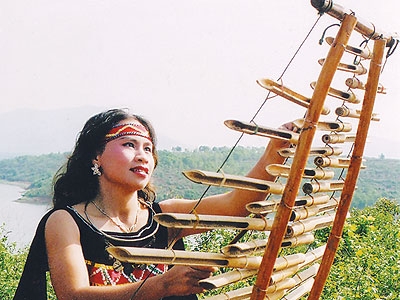T'rung is one of the popular musical instruments closely associated with the spiritual life of the Bahnar, TSedan, Giarai, Ede and other ethnic minority groups in the Central Highlands of Vietnam.
This traditional folk-musical instrument is made of short bamboo tubes differing in size, with a notch at one end and a beveled edge at the other. The long big tubes give off low-pitched tones while the short small ones produce high-pitched tones. The tubes are arranged lengthwise horizontally and attached together by two strings.
In the majestic Central Highlands, T'rung is often played after back-breaking farm work and during evening get-togethers in the communal house around a bonfire with young boys and girls singing and dancing merrily. The sounds of the gong and T'rung also mingle together at wedding parties and village festivals.
Over the time, T'rung instrument has been largely improved. More tubes have been added, and at times as many as 48 tubes are arranged in three arrays capable of performing intricate piece of modern music while preserving the traditional sound scale. Some players have even invented a stick notched at both ends for a single hand to produce two sounds at the same time, heightening the artistry of the instrument.
Vietnam's national music bands have never neglected the role of T'rung, an instrument which is original and made of simple materials, but highly appreciated at performances in the famous musical halls of many foreign countries.






































































































